Home | Category: Coastal Areas
MANGROVES
 Mangroves are small, scrubby, salt-tolerant trees supported by prop roots, with branches that intertwine like “dense jungle gyms”. There are many species of mangrove. Though mangrove species often look the same or similar, they are often not members of the same family. Many come from different families not even closely related. Different mangrove species are simply plants that came up with the same strategy to survive in a specific environment as plants in the desert have. [Source: Kennedy Warne, National Geographic, February 2007; John P. Wiley, Jr., Smithsonian magazine]
Mangroves are small, scrubby, salt-tolerant trees supported by prop roots, with branches that intertwine like “dense jungle gyms”. There are many species of mangrove. Though mangrove species often look the same or similar, they are often not members of the same family. Many come from different families not even closely related. Different mangrove species are simply plants that came up with the same strategy to survive in a specific environment as plants in the desert have. [Source: Kennedy Warne, National Geographic, February 2007; John P. Wiley, Jr., Smithsonian magazine]
Mangroves are essentially terrestrial plants that have adapted themselves to living in salt water and mud saturated with hydrogen sulfide (the chemical that produces the rotten egg smell) and salt and is rich in organic matter (up to 90 percent) but deficient in oxygen.
Mangrove swamps are difficult to explore. The roots form an impregnable tangle of interlocking roots that make boating through them impossible. Sometimes the roots are covered with a variety of sea creatures and can be as colorful as reefs.
Mangrove swamps are easiest to explore on foot at low tide. But even then making your way through them is no piece of cake They are often covered by barnacles and shells that cut hands and legs. The mud can suck off shoes, stick to the body and swallow people up to their knees. The air is humid, full of mosquitos and the smell of decay and rotten eggs (swamp gas).
Related Articles: COASTAL AREAS: PROCESSES, LANDFORMS AND LIFE ioa.factsanddetails.com ; ISLANDS: TYPES, HOW THEY FORM, FEATURES AND NATIONS ioa.factsanddetails.com ; BEACHES: SAND, SURF AND FOAM ioa.factsanddetails.com ; BEACH SAFETY, DANGERS AND HAZARDS ioa.factsanddetails.com ; TIDAL POOLS, INTERTIDAL ZONE AND LIFE FOUND THERE ioa.factsanddetails.com ; SEAGRASS— FEATURES, ECOSYSTEMS AND THE WORLD’S OLDEST AND BIGGEST PLANTS ioa.factsanddetails.com ; WETLANDS, MARSHES AND ESTUARIES ioa.factsanddetails.com ; SEAWEED: FOOD, HEALTH, FARMING AND CLIMATE CHANGE ioa.factsanddetails.com
Websites and Resources: Animal Diversity Web (ADW) animaldiversity.org; National Oceanic and Atmospheric Administration (NOAA) noaa.gov; “Introduction to Physical Oceanography” by Robert Stewart , Texas A&M University, 2008 uv.es/hegigui/Kasper ; Fishbase fishbase.se ; Encyclopedia of Life eol.org ; Smithsonian Oceans Portal ocean.si.edu/ocean-life-ecosystems ; Woods Hole Oceanographic Institute whoi.edu ; Cousteau Society cousteau.org ; Monterey Bay Aquarium montereybayaquarium.org ; MarineBio marinebio.org/oceans/creatures
Mangroves, Tides, Freshwater and Saltwater
Kennedy Ware wrote in National Geographic, mangroves are “brilliant adaptors. Each mangrove has an ultrafiltration system to keep much of the salt out and a complex root system that allows it to to survive in the intertidal zone. Some have snorkel-like roots called pneumatophores that stick of the mud to help them take in air; other use prop roots or buttresses to keep their trunks upright in the soft sediments at tide’s edge.”
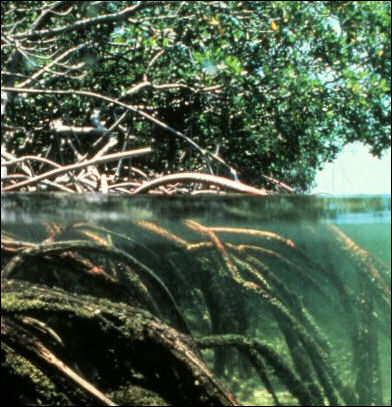 Mangroves survive in the salty, brackish water with various kinds of safeguards: membranes that prevent salt from entering the roots, glands on the leaves that secrete salt or move it to leaves that are about to fall off. These adaption help mangrove carve out a niche for themselves where other plants can't grow.
Mangroves survive in the salty, brackish water with various kinds of safeguards: membranes that prevent salt from entering the roots, glands on the leaves that secrete salt or move it to leaves that are about to fall off. These adaption help mangrove carve out a niche for themselves where other plants can't grow.
Different mangroves deal with salt water incursions in different ways. Those that move it dying leaves carry the salt water through the stems and deposit it leave salt ready to fall off a die. Those that have glands on their leaves secrete it in concentrations that are 20 times stronger than the sap and stronger than saltwater. Saltwater is damaging to plants and every effort is made to conserve freshwater. The leaves contain mechanisms similar to these found in desert plants to prevent evaporation
Salt marshes and mangrove forest have traditionally served as filters between land and sea. Mangroves have to deal with high tides that swamp the plant and low tides that expose the roots and deal with water that can range from almost completely fresh to completely salty. Currents deposit and remove mud. Some mangroves can live on dry land away from salt water.
Mangrove Areas
Nearly 75 percent of the coastlines in the tropics (between 25 degrees north and 25 degrees south) have some kind of mangrove covering. Although most are found within 30 degrees of the Equator some hardy varieties such as those found in New Zealand have adapted themselves to temperate climates.
Mangroves are most prolific in Southeast Asia, where they are thought to have originated, with the largest total area of mangroves in Indonesia. The Indo-Pacific mangroves are generally richer in species and dense growth than mangroves found elsewhere. In parts of Sumatra mangroves are marching into the sea at a rate of 115 feet a year; in Java advance rates of a 180 feet a year have been recorded. There are 60 species in the Indo-Pacific region compared to only 12 in the New World and three in Florida (the red, the black and the white).
Mangroves in the Asia-Pacific region are harvested for wood for paper. They are also excellent land builders. Their interlocking roots stop sediments from traveling out sea and instead cause them to settle around the mangroves. As mud accumulates on the seaward side of a swamp, mangroves advance and claim it using special seeds that germinate while still hanging from a branch. The seeds sends down green spear-like shoots which may up to 40 centimeters long. Some aboriginals in northern Australia believe their primal ancestor used mangroves to walk across the mudflats to bring trees into existence.

Mangrove areas worldwide
Mangrove Plants and Seedlings
Mangroves sit like platforms on the mud. Their roots are imbedded in the mud just deep enough so plants don't wash away. The areal roots also spread out in such a way that act like buttresses.
The plants that form mangrove forest are surprisingly diverse, There are 80 species from two dozen families, including palms, hibiscus, holly, plumbago, acanthus, legumes, and myrtle, ranging from prostrate shrubs to 65-meter timber trees. All of these trees grow in areas with low-oxygen soil, where slow-moving waters allow fine sediments to accumulate. Mangrove forests only grow at tropical and subtropical latitudes near the equator because they cannot withstand freezing temperatures.
Fully developed mangroves are very stable. The same can also be said for seedlings. Some species let their seed germinate on their root. The seedlings drop off into the soft mud when they are about two feet high and send out roots at astounding rates to establish themselves.If the seedlings fall during high tide they can be carried a considerable distance and survive up to a year and feed and grow during that time. Floating seedling hang horizontally in the water and photosynthesize using green cells on their skin. If they float into an estuary they become vertical and implant themselves in mud. Although the journey is treacherous floating seedling have a better chance of survival than ones that drop near its parents, where competition and crowding are fierce.
Samantha Chapman wrote in The Conversation: Plants have less ability to move than animals, but some — particularly mangroves — can disperse via water over thousands of miles. Mangroves release reproductive structures called propagules, similar to seeds, which can produce new plants. They float and are distributed by ocean currents and, sometimes, big storms. [Source: Samantha Chapman, Associate Professor of Biology, Villanova University, The Conversation, February 9, 2018]
Mangroves, Oxygen and Carbon Dioxide
Mangrove roots, like those of other plants, need oxygen. Since estuarine mud contains virtually no oxygen and is highly acidic, they have to extract oxygen from the air.
Mangrove roots extract oxygen with above-ground, flange-like pores called lenticels, which are covered with loose waxy cells that allow air in but not water. Some species of mangrove have the lenticels on their prop roots. Others have them on their trunks or have pneumatophores (fingerlike projection that grow up from the organic ooze). A single large tree such as “Sonneratia alba” can produce thousands of rootlike snorels that radiate out in all direction.
 Scientists have determined carbon inputs and outputs of mangrove ecosystems by measuring photosynthesis, sap flow and other process in the leaves of mangrove plants. They have found that mangroves are excellent carbon sinks, or absorbers of carbon dioxide.
Scientists have determined carbon inputs and outputs of mangrove ecosystems by measuring photosynthesis, sap flow and other process in the leaves of mangrove plants. They have found that mangroves are excellent carbon sinks, or absorbers of carbon dioxide.
Research by Jin Eong On, a retired professor of marine and coastal studied in Penang, Malaysia, believes that mangroves may have the highest net productivity of carbon of any natural ecosystem. (About a 100 kilograms per hectare per day) and that as much as a third of this may be exported in the form of organic compounds to mudflats. On’s research has show that much of the carbon ends up in sediments, locked away for thousands of years and that transforming mangroves into shrimp farms can release this carbon dioxide back into the atmosphere 50 times faster than if the mangrove was left undisturbed.
Benefits of Mangroves
Mangrove forests stabilize the coastline, reducing erosion from storm surges, currents, waves, and tides. The intricate root system of mangroves also makes these forests attractive to fish and other organisms seeking food and shelter from predators.
Mangrove forests provide vital habitat for endangered species from tigers and crocodiles to rare humming birds the size of a bee. Kennedy Ware wrote in National Geographic, “Forest mangroves form some of the most productive and biologically complex ecosystems on Earth. Birds roost in the canopy, shellfish attach themselves to the roots, and snakes and crocodiles come to hunt. Mangroves provide nurseries for fish; a food sources for monkeys, deer, tree-climbing crabs... and a nectar source for bats and honeybees.”
Achin Steiner, United Nations Under-Secretary General told the Times of London. “We already know that marine ecosystems are multitrillion-dollar assets linked to sectors such as tourism, coastal defense, fisheries and water purification services. Now it is emerging that are natural allies against climate change.”
Mangrove and Coastal Zone Life
Ferns, vines, orchids, lilies, terns, herons, plovers, kingfishers, egrets, ibises, cormorants, snakes, lizards, spiders, insects, snails and mangrove crabs thrive on land or upper parts of the mangrove plants. Barnacles, oysters, mussels, sponges, worms, snails and small fish live around the roots.
Mangroves water contain crabs, jellyfish and juvenile snappers, jacks, red drums, sea trout, tarpon, sea bass, snook, sea bass. The only sharks and barracudas are babies.
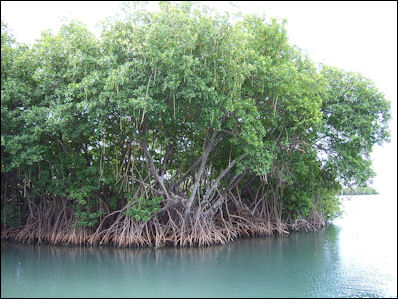
Puerto Rico
Lemon sharks give birth to live young and breed in shallows and young sharks spend their first year around mangrove swamps, feeding on small fish and crustaceans and staying shallow waters were there are less vulnerable to attacks from larger fish, especially other sharks. In the Bahamas there are large numbers of youngsters living in mangrove swamps which offer them a plentiful supply of food and few dangers than in the open sea and around reefs.
Mangroves begin the food chain by transforming sunlight into energy and food that support microorganisms that in turn support larger and larger animals. Leaves that fall in the water are broken up crabs and snails and in turn provide nutrients for other life forms.
Pieces of leaves are attacked by bacteria, fungi and yeasts that break down the leaves into particles that can be consumed by protozoa and microscopic animals. They are fed on by small fish, worms, crustaceans and other invertebrates. They in turn are fed on by crabs and bigger fish, which are sometimes gobbled up by herons and eagles.
See Fiddler Crabs and Mudskippers
Mangrove Snails Predict Tides
Some mangrove snails avoid being submerged by crawling up and down mangrove roots. They have an acute sense of timing and anticipate tide changes by moving up and down the roots just ahead the rising and falling water. When they tides are at their highest each months they stay at the highest perch and don’t drop down at low tide.
Erin Espelie wrote for LiveScience: Imagine trying to gauge the tides that sweep through a Kenyan mangrove forest: how far the water rises up a given tree depends on the season, the phase of the moon, and the tree's position. Yet a pinkie-toe-size snail, Cerithidea decollata, seems to predict the height of the incoming tide. It ascends a trunk just high enough to escape inundation, then descends when it's safe to forage in the mud below. To find out how, Marco Vannini of the University of Florence and colleagues observed the snails on plastic pipes — imitation mangrove trunks — that they stuck into the mud. [Source: Erin Espelie, LiveScience.com, October 15, 2008]
The scientists tried obscuring any chemical markers left behind by the tide line or the snails themselves, and still, the snails climbed to the right height. Nor do the predictive gastropods seem to be using visual cues from overhead foliage. They aren't even counting the "steps" they must creep to beat the tide: when the scientists tilted the pipes, the snails readily climbed the extra length.
When lead weights were glued to the snails' shells, however, they adjusted their ascents; the heavier the weight, the shorter the climb. So it seems that the snails' are sensitive to their own energy output. Perhaps, Vannini suggests, they actually perceive the variations in gravity that drive the tides: before a low tide, the snails feel heavier and therefore don't climb very high.
Benefits of Mangroves to Coastal Areas and Humans
Preserving mangroves is vital to people that live in coastal areas, providing them with fish and other seafood and offers protection from storms and tsunamis. Natural coastal environments and mangroves also play a vital role in absorbing carbon dioxide and combating climate change.
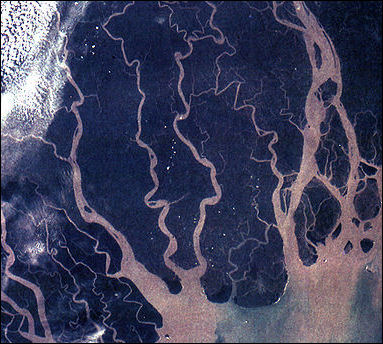
Ganges River Delta, Bangladesh India
Mangroves are useful in many ways. Many commercial important fish and crustaceans spend part or all of their lives in mangroves, which also provide a home of many terrestrial animals. Some 250-acre sections of mangrove produce four tons of shrimp a year.
Mangroves also produce three tons of organic matter per acre a year; protect shorelines from winds, waves and erosion and provide lumber, firewood, charcoal, tannins, medicines, food and alcoholic beverages. Local people do things like harvest wild honey and collect reeds for roof thatching and baskets.
All types of coastal wetlands help to prevent millions of dollars in damage from flooding and save hundreds of hours of labor to repair storm damage. Mangrove forests are vital for protesting farmland from salt water intrusion and buffeting the effects of tropical storms. The great tsunami of 2004 demonstrated how they can save thousands of lives by blunting the force of tsunami waves.
Threats to Mangroves and Coastal Areas
Mangroves are regarded by some as the world’s most endangered habitat, with more than third being lost between 1980 and 2000. Parts of Asia have lost 90 percent of their mangrove forests., robbing fish of a place to spawn and people protection from storms. One estimate in the mid 2010s suggested that mangrove deforestation rates in recent decades had been three to five times faster than other forests around the globe. [Source: Samantha Chapman, Associate Professor of Biology, Villanova University, The Conversation, February 9, 2018]
Coastal habitats have been lost to development, shrimp farms, fish farms and land reclamation. Run off, agriculture, overfishing, dumping of garbage, surface mining and construction all degrade the coastal environment. Untreated raw sewage, industrial chemical and other pollutants are released directly into the sea. Even in the United States this is still occurring on a grand scale.
Houses and hotels are built too close to the water. Dredging and filling have destroyed near shore habitats. Oil spills equal in size to the Exxon Valdez spill occur on average around the world every eight months. In some places the accumulation of pollutants is so bad that dead zones — areas where there is so much algae that all the oxygen is sucked out of the water making it impossible for most life forms to exist — have sprung up. There are nearly 150 of these worldwide. Even when progress is made improving water quality the improvements can not keep up with the waste produced by the increasing number of people that are migrating to coastal areas all the time.
Mangrove forests are being destroyed to make way for coastal development, salt pans, port facilities, farms, golf courses and roads. The mangroves themselves are chopped up to provide chips for the production of rayon or processed into charcoal in rudimentary ovens. They die as a result of pollution, oil spills, sediments overlaid and disruption to their sensitive water and salinity balance.
Perhaps the biggest threat comes from shrimp farms, which are easy to set up in mangrove areas and provide much need jobs in poor countries, When there a choice between leaving a mangrove undeveloped for the sake of the fish and crabs and carbon-consuming tree or developing the site for money and jobs you know who is going to win out. To make matters worse, shrimp farmers typically abandon their ponds after a few years to avoid disease outbreaks and declining productivity and move to new sites, leaving behind degraded areas and plowing up new ones.
Mangroves and Climate Change

Before shrimp farming, Honduras 1987 Samantha Chapman wrote in The Conversation:Mangroves line the world’s coastlines and prefer warm temperatures, so they have traditionally been restricted to subtropical and tropical environments. But they have many features that have enabled them to survive major climate shifts in the past. Now, in a harbinger of climate change, mangroves are expanding from tropical zones into temperate areas. Scientists are finding them at higher and higher latitudes in North America, South America, Asia, Africa, Australia and Latin America. [Source: Samantha Chapman, Associate Professor of Biology, Villanova University, The Conversation, February 9, 2018]
Working with other ecologists in the shadow of the huge launch complex at Florida’s Kennedy Space Center, we have found that mangroves have increased in abundance by 70 percent in just seven years over an area of 220 square miles (567 square kilometers). This is a dramatic change in the plant community along this stretch of the Atlantic coast. Unlike many other impacts of climate change, we expect these shifting ranges to produce some benefits, including increased carbon storage and storm surge protection.
As mangrove propagules drift north along the Atlantic coast, they are reaching areas where winter freeze events that could kill them are becoming less common due to climate change. Similar movements are occurring in other locations around the world.
In the Gulf of Mexico and Florida, mangroves are increasingly found in areas recently dominated by salt marshes, which typically occur in cooler zones. Using satellite images and land-based field studies in our ongoing study of mangroves, we can see this spread of mangroves occurring faster than we could have expected based on climate data alone.
Though these shifts also likely happened in the past due to hurricanes and freeze events, the recent changes in mangrove range are still dramatic. One study from Florida shows that mangroves from northern populations may be reproducing earlier than normal and producing bigger propagules, which could help them take over salt marshes.
In a recent modeling effort, we examined how mangroves protect NASA facilities at the Kennedy Space Center. We found that a 2-meter-wide strip of mangroves along the shore can reduce wave height by 90 percent. In contrast, it takes 20 meters of salt marsh habitat to reduce waves by the same amount. Other studies have found that mangrove forests helped reduce shoreline damage during the catastrophic 2004 Indian Ocean tsunami and Tropical Storm Wilma in Belize in 2005.
Mangrove Conservation
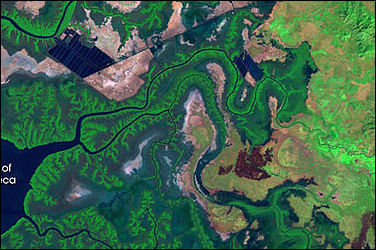
After shrimp farming, Honduras 1999 A United Nations task force on mangroves and the environment recommending: 1) setting up a blue carbon fund to help developing countries to protect mangroves as well as rain forests; 2) place a value on mangroves that takes into consideration their value as carbon sinks; and 3) allow coastal and ocean carbon sinks to be traded in same fashion as those for terrestrial forests. Christian Nellemann, an author a United Nations report on the issue, told the Times of London, “There is an urgency to act now to maintain and enhance these carbon sinks. We are losing these crucial ecosystem much faster than rainforests and at the very time we need them. If current trends continue they [mangrove and coastal ecosystems] may be largely lost within a couple of decades.”
Countries need to set aside protected areas where nature is allowed to run its course without human interference. Managing these habitats is often far less expensive than repairing degraded habitats. In Asia, for example, careful management of mangroves has proved far more effective in protecting coastal areas from storms, surges and waves than man-made coastal defenses. In some places mangrove trees are being planted to create coastal wetlands that will act as a barrier against storms and the effects of sea level rises.
Samantha Chapman wrote in The Conversation: Mangrove restoration efforts are ongoing in many parts of the world, including the Tampa Bay estuary and southern China, but some projects have been major failures. To succeed, these initiatives need to consider mangrove habitat needs, particularly hydrology. Though mangroves may protect coastlines even more effectively than salt marshes, it is important to note that marsh plants provide important habitats for numerous species of birds and fish. We don’t yet know how these animals will fare as mangroves replace marshes, nor do we yet understand other downsides of plant range shifts due to climate change. [Source: Samantha Chapman, Associate Professor of Biology, Villanova University, The Conversation, February 9, 2018]
Mangrove loss has dropped world-wide from one to two percent a year to less than 0.2 per cent, , But that doesn’t mean we should let down our guard. “Even if we are losing fewer mangroves than in the past, we are still talking about roughly 20,000 hectares a year,” says Professor Martin Zimmer, who heads the Mangrove Ecology Working Group at the Leibniz Centre for Tropical Marine Research (ZMT) in Bremen, Germany, “Over the last 50 years, in total, more than a third of the world-wide mangrove stocks has either been logged or destroyed.”
See Creating Desert Wetlands Under DESERT AGRICULTURE AND IRRIGATION factsanddetails.com
Benefits of Mangroves in the Fight Against Global Warming
Samantha Chapman wrote in The Conversation: Continued mangrove expansion could increase carbon storage along coastlines. Mangroves have an enormous capacity for sucking up carbon dioxide and other greenhouse gases and trapping them in flooded soils for millennia. They are among the most carbon-rich tropical forests and can store twice as much carbon on a per-area basis as salt marshes. During normal growth, mangroves rapidly convert carbon dioxide into biomass. The saturated soils in which they grow contain low levels of oxygen, which bacteria and fungi need as fuel to break down dead plant matter. Instead, this dead material is stored in the soil. [Source: Samantha Chapman, Associate Professor of Biology, Villanova University, The Conversation, February 9, 2018]
We estimated in one study that mangrove carbon storage at the Kennedy Space Center increased by 25 percent in only seven years as mangrove forests spread. We concluded that if mangrove expansion continued unchecked by freezes into other southeastern U.S. wetlands, wetland carbon storage could result in the uptake of 26 million metric tons of carbon by 2080. This is equivalent to just over 95 million metric tons of carbon dioxide, which is about 28 percent of Florida’s total greenhouse gas emissions from human activities in 2010.
Preserving coastal mangroves improves climate resilience in several ways. First, if the carbon stored in these soils were released as carbon dioxide and methane, this would likely cause an increase in climatic warming. Second, the same processes that store carbon in wetland soils also allow these wetlands to accrete sediment and keep pace with rising sea levels.
Scientists Warn Against Mass Planting of Mangroves
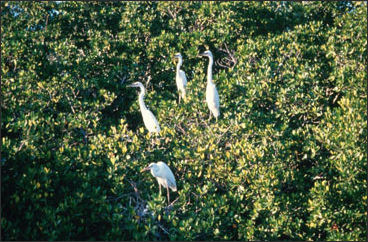 In the spring 2021, mangrove experts of the International Union for Conservation of Nature (IUCN) warned against mass planting because important ecological prerequisites are not considered. Presented their concerns in their Position Paper “Pause before you plant”, they said that although global mangrove conservation and reforestation efforts have been partly successful IUCN researchers are wary of mass plantings of mangrove seedlings. [Source: Rural 21, May 1, 2021]
In the spring 2021, mangrove experts of the International Union for Conservation of Nature (IUCN) warned against mass planting because important ecological prerequisites are not considered. Presented their concerns in their Position Paper “Pause before you plant”, they said that although global mangrove conservation and reforestation efforts have been partly successful IUCN researchers are wary of mass plantings of mangrove seedlings. [Source: Rural 21, May 1, 2021]
Rural 21 reported: The IUCN group comprises mangrove experts from across the world. IUCN scientist Professor Martin Zimmer said: “For some time, we in the IUCN Mangrove Specialist Group have been observing with concern a sort of doing things for the sake of doing things which often goes hand in hand with planting mangroves. Of course it should be welcomed that people are taking action to save the mangrove forests, but unfortunately, in the long run, many of these projects will not meet with success.”
The scientists believe that there are several reasons for setbacks. Often, projects aimed at restoring mangrove forests fail because, especially in the case of mass planting, important ecological prerequisites are not taken into account. For example, mangroves are planted on sites exposed to strong currents, so that the young seedlings which have not yet taken root are simply washed away. “Mass planting campaigns may have a good media impact, but often, they focus on only one or two species which are easy to plant,” Zimmer explains. “Frequently, this results in stocks which do not render the desired ecosystem processes and services. Often, little stress-resistant monocultures or species are established which are not indigenous, become invasive and may result in ecological problems.”
The experts argued that in many cases greater emphasis should be places on preserving the mangroves we already have rather than producing new ones. Countries such as Sri Lanka and Indonesia have made efforts to protect the remaining mangrove forests along their coasts. The said: “We first of all recommend relying on the natural regeneration potential of the mangroves. If we can restore the original environmental conditions, the mangrove will be strong enough to spread again. Wherever this is not possible, or where particular ecosystem services are to be achieved, reforestation can represent a solution, but only under suitable ecological conditions.”
Image Sources: Wikimedia Commons; YouTube, Animal Diversity Web, NOAA
Text Sources: Animal Diversity Web (ADW) animaldiversity.org; National Oceanic and Atmospheric Administration (NOAA) noaa.gov; “Introduction to Physical Oceanography” by Robert Stewart , Texas A&M University, 2008 uv.es/hegigui/Kasper ; Wikipedia, National Geographic, Live Science, BBC, Smithsonian, New York Times, Washington Post, Los Angeles Times, The New Yorker, Reuters, Associated Press, Lonely Planet Guides and various books and other publications.
Last Updated March 2023
